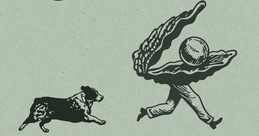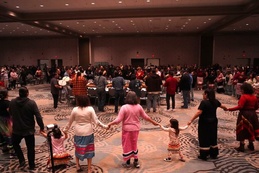The Legacy of Holy Childhood
Aug. 3, 2008
This is the third in a four-part series on Holy Childhood School of Jesus. The first two stories on the school in Harbor Springs focused on the sexual abuse of nine young male students at the hands of two Roman Catholic nuns.On a bleak November day in 1885, a handful of nuns walked into Holy Childhood School of Jesus and began their mission of saving the poor Indian children of Northern Michigan.
So says a 1960 history of the Indian boarding school, which is titled in childlike handwriting on a blackboard: “the problem can be solved.”
The school was run by the School Sisters of Notre Dame, an international group of Catholic nuns that remains devoted to schooling underprivileged children. It ran on a shoestring budget and relied on local people and church members for money.
The school opened in 1829 as a small log cabin. It grew into a stately three-story building and closed in 1983 due to low enrollment. The building was demolished last fall, with a new parish building to rise in its stead.
With such a long history, there is no single way to characterize the boarding school. But if you are a middle-aged Native American and a former student, chances are good that you’ll never forget the Roman Catholic nuns of Holy Childhood School.
A NUN’S LIFE
The three-story brick school was in the heart of Harbor Springs, which is known today as a playground for the rich. But the lives of the nuns couldn’t have been less affluent. A tour of the school before it was torn down reveals few creature comforts.
The nuns’ bedrooms were tiny with a single window. Each day they cared for over 200 children. Besides the Indian children, the nuns also taught white day students who lived in Harbor Springs.
According to the 1960 history of the school, “the nuns arose at 3:30 a.m. making clothing and bed clothing for their pupils, pumping wash water from an outdoor well and scrubbing the mounds of soiled clothing on washboards, working in the gardens to insure food for the winter. Their tasks were, and still are, endless.”
The kids also lived a bare bones existence. The children were put to work to help the school run—peeling potatoes, picking apples, varnishing banisters, and scrubbing floors. The toughest jobs were done in the basement, such as grinding up donated animal bones to use as plant fertilizer.
Kids typically came from homes with no electricity or heat, and would arrive at school with all their belongings in a cardboard box. They’d get to wear “new” clothes donated by the townspeople, returning them at year-end when they outgrew them.
The 1960 history speaks of the love the nuns held for children: “Their story is one of sacrifice and continual poverty, endured not for fame or fortune, but for the glory of God and the welfare of Indian children.”
But the school had a severe edge to it, perhaps owing to a strict religion that prized sacrifice and obedience. The sisters handled the kids (each assigned a number) with a military approach and a rote style of teaching. Some students said it felt like an eight-year sentence of fear.
Minnie Wabanimkee (her student name was Dolores Miller) said she tried to be “quiet as a mouse.” She was too afraid to ask for more blankets at night, so she shivered through the winter nights. She had a bad cough and a few bouts of pneumonia requiring hospitalization.
Cindi John, 50, only attended the school in third grade, and didn’t have the sense to be afraid, she said laughing.
“I remember once asking to go to the bathroom when it wasn’t recess, and the whole class got deadly silent. ‘Oh my God, I can’t believe she’s asking that.’ I did get to go, but I’d get a spanking on the way. I once asked for more porridge, and the other kids just gasped.
“I look like a white person and I didn’t have the same experiences as a person with dark skin. Yet I have seen the oppression of the brown people, and to me it was real mental abuse. To sum it up, those places were really bad for a lot of people. It’s hard to tell non-natives that, who loved the boarding school.”
ARRIVING
Yvonne Walker Keshick remembers driving up to the school with her dad and four siblings, each with clothes packed in a cardboard box.
“My dad parked the car. ‘This is school. You kids be good.’ Another car pulled up, beer cans fell out, a cardboard box flew out, and a boy tumbled out of the car. The car drove off. My dad went up to the school and rang the doorbell. Nuns came to the door. Kids were peeking around the corner. All you could smell was homemade bread. The nuns said to my dad, ‘We’ll take good care of your kids.’ She was really nice, but as soon as dad left, the door barely closed and she yelled, ‘Now get to where you belong, heathens!’”
The stories of the Indian families are similar in some ways — families tended to be very large and parents stressed. One parent might have abandoned the family, leaving the other unable or unwilling to carry on. Some of the kids arrived from homes where there was alcoholism and little discipline. Others, like Bob Kewaygoshkum, came from homes where there was a recent death.
“I had a happy childhood when I was very, very young,” recalled Kewaygoshkum, who attended school from 1959 to 1965 and now serves as chairman for the Grand Traverse Band of Ottawa and Chippewa Indians.
“My grandma and grandpa raised me. They spoke the language, picked herbs. My grandma passed on, and one day, they knocked on the door. You’re coming with me. Your grandfather cannot take care of you. I went with this little old white lady. Boom! I went to this school, got my hair cut, had to speak the language. It was a shock. I’d go there in the school year, and in the summer time, I stayed with foster parents. Don’t get me wrong, they were good foster parents, and my grandfather visited me at the school every weekend. But from then on, I never got to stay with my grandfather. He passed on in 1965. The biggest question in my mind was nobody told me why. Why did they put me there?”
Nothing is said in the school’s history about how the children were recruited, but many former students gave the same story. Parents were told that their homes were unfit and they had to send their kids to Holy Childhood or put them into foster care.
Paul Raphael, 51, was one of nine kids who attended Holy Childhood.
“I asked my mom afterwards, why did I have to go? She told me that at that time, in the early 1960s, they were coming through Peshawbestown and taking kids away from parents. Pretty much all the houses didn’t have running water or electricity. They didn’t consider them fit to live in, so they’d put all the kids in boarding school. She said the school was the only way of keeping us together.”
SHAMING
Former students said they didn’t mind the labor or food (a lot of rice and porridge) as much as the corporal punishment and shaming.
“I’ll give you one little example,” said Ron Paquin, 65, a birch bark canoe maker from the Sault Ste. Marie Tribe of Chippewa Indians, who recently received the Michigan Heritage Award for his work.
“I had a bed-wetting problem. They’d put the sheet over my head where the pee was. Then I’d have to stand out in the sun with the sheet over my head while the girls laughed at me.”
Everybody saw something different, said Kewaygoshkum.
“I didn’t experience a lot of the bad that a lot of people did. I minded my own p’s and q’s. I kept myself right in line. The nuns were strict back in those days. I think that at any Catholic school back then, all the nuns were mean.”
Kewaygoshkum has fond memories of taking care of the skating rink for the little kids. “We’d go skating, sledding, ice skating, you’d go on long walks with 30 to 40 kids. … I’d just be quiet and watch things that went on around me. I got a good basic Catholic education, and that really helped me out in my high school years. A lot of those years, I worked in the kitchen. You figured you got fed anyway. It was a great job. Sometimes we waxed floors, things like that. We got to pick apples and potatoes, and that gave us freedom. I saw some of the spankings they gave out with the wide part of the oar. I saw that.”
Yvonne Walker Keshick attended school from 1958 to 1966 with three sisters and a brother. She said her maiden name of Walker — unbeknownst to her — seemed to carry dishonor. She was told she’d get pregnant and never make anything of herself.
Yet, she said, not all the nuns were bad. In fact, a few — like the cook — were kind and treated her with dignity. Sister Mary Onesima Josia, the only Holy Childhood student to become a nun and teacher there, was assistant cook and gave kids advice.
“She’d tell us, make sure you do everything you’re told,” Keshick said.
But the mean nuns scarred her memories. If she couldn’t solve a problem on the chalkboard, the teacher would smash her face into it.
The experience traumatized her, and now the simplest math problem causes panic, said Keshick, 56, who is a nationally respected quill box maker.
Another nun regularly hit her younger sister, who tended to be slow. “I was afraid,” Keshick said. “My dad had never spanked us. He respected us.”
Paul Raphael, 51, said the nuns would beat them down psychologically.
“They used to call us worthless, stoic Indians. We wouldn’t amount to anything. Our parents are worthless, we were worthless. That’s why we were there. To get a proper upbringing.”
Paquin said he heard the words “breed” for the first time from the mouths of nuns.
Raphael said that one nun would use a dusting broom. One nun hit a little girl so hard, she flew off her chair.
“I only did a six month sentence,” said Scott Schwander of Traverse City, but added that his memories are still vivid of the violent nun who served as the house mother, whose job was to oversee the older boy’s dormitory.
“My mom called this house mother to tell her that she would pick me up early from school on Good Friday. The house mother got so angry that I was being taken out of school early on Good Friday that she went into a tantrum. She grabbed this little boy by the hair and started shaking him around by his head. I saw his feet leave the floor. She had him spinning in circles.
“During her rage, she walked over to this bed where a boy named Curtis was laying. He was crying, laying on his stomach. She grabbed the bed rails, said ‘God dammit!,’ and flipped the bed over on top of Curtis. All this because my mom was taking me home early for break. When my mom arrived, the house mother was all smiles and playing ‘nicey-nicey.’ I thought I did something wrong. I thought I was next.”
Raphael said this same house mother—who was also accused of sexually abusing several young boys—made him kneel on a stairway all night long. “It was cold, but the kneeling was the hardest part of it. We tried to sit down, and she came out and yelled at us. ... The third grade teacher was real mean. She’d beat you with the edge of a ruler if you didn’t know the answer, and she just kept slapping and slapping your hand if you couldn’t come up with the answer. But if you didn’t know it, you didn’t know it.
I figured this is how white people act, and that’s why we were always told to stay away from them,” said Raphael, who had never experienced violence at the hands of his family.
Keshick said she raised her first two children with the same disciplinary approach and even enrolled them in Holy Childhood when she was temporarily homeless. But she later befriended elderly Indian women, who persuaded her to quit alcohol and instilled a sense of spirituality. She raised her third child, a daughter, with a more gentle touch. She also manages the archives for the Little Traverse Bands of Odawa Indians, and helps people research and cope with their past.
Like Keshick, Raphael carried bad behaviors from school—as a teen, he was violent toward both men and women. The elders of the tribe took him under their wing and helped him find a better way. He has since devoted his life to helping others heal, and works as a peacemaker at the Grand Traverse Band’s tribal court.
GRATEFUL MEMORIES
Yet other students feel very grateful for the school. Henry Negake, 70, who attended the school from third to eighth grade, said the nuns were disciplinarians, but corporal punishment was common at the time. He and his sister couldn’t ask for a better education.
“Our teachers were top notch—just the best. I don’t think they could do any better being teachers. Coming away from there, 50 years later, we credit our mathematical ability and language skills to that school. I started going to public school in eighth grade in Roscommon, and it took me until then to realize how far advanced I was from the public school kids,” said Negake who custom manufactures canvas for yachts in Fort Lauderdale, Florida.
Cindi John, said a friend told her that Holy Childhood had saved her life. “Her mom drank and got mean when she was drinking, so for her, it was a warm place to sleep and there was food there.”
A nun who worked there for decades and later married an employee of the school declined to be interviewed. But she did explain that she and the other nuns did the best they could with the “wild kids,” who came from homes where discipline was weak and alcoholism rampant. “They like to blame their alcoholism on the boarding school, but it wasn’t our fault,” she said.
Many students have called to thank her since graduating, and some showed up at the school’s closing ceremony where tribal leaders said it was time to put the school’s history behind them and to heal.
The stories of beatings were hearsay, she said. She couldn’t remember seeing a single child beaten. Yet this particular nun’s name frequently came up as one of the offenders, suggesting that she believes her actions were normal.
Wabanimkee, 53, remembers the nun repeatedly slugging her back and shoulders, furious that she had lost a button on a favorite jumper.
Generally, the beatings occurred after the day students—residents of Harbor Springs—went home. Keshick remembers one exception when the students returned to the classroom after recess, and an Indian boy began playing with a table leg that had fallen off the table. The kids were fighting over the “gun” when the nun came in and accused the boy of breaking off the table leg. She took him into a closet and beat him, while the day students became quiet, horrified by the screams.
When the nun emerged from the closet, she didn’t say a word and continued on with her lesson.
Mary Coniczke, spokeswoman for the Sisters of Notre Dame, said that that corporal punishment wasn’t confined to Roman Catholic schools. It was also used in public schools, and both systems eventually replaced the paddle with a less painful approach.
“There was a shift and more enlightenment on what was the best way to work with children. The structure and expectations were good, but we needed to find a better way to bring them to that,” she said.
LONELINESS
Despite the varied memories, all the former students remember their heartache of leaving their families and being cut off all things Indian.
“I went to the boarding school the year after my dad died in 1973,” said Scott Schwander. “We were renting a trailer in Leelanau County and had no car. I was shuttled to the Traverse City public schools, but couldn’t get to school in case I missed the bus. So my mom sent me to the school after Christmas, and it hurt like hell. There was no greater pain or empty feeling than watching your family leave and you couldn’t go with them.”
He is grateful, however, for being exposed to the Catholic religion, which provided the beginnings of a spiritual life.
Kewaygoshkum said kids would get so desperate, they’d run away. He kept quiet and told no one. “I just thought, I just hope they make it home.”
A group of girls from Peshawbestown tried to run away in their pajamas in the 1960s. They were found, brought back, and terribly beaten over the next several days, first by nuns and a priest, who used a horse whip, Keshick said.
A Cross Village woman said the same thing happened to her husband, who ran away three times over three years when he attended school in the 1950s. The priest made him strip naked and horse-whipped him in front of his co-escapee. He now has bouts of heavy drinking, she said.
“Just because the building is gone, doesn’t mean it’s gone from their hearts and souls. It’s sickening. People say the Indians have a lot of problems with alcohol, and I think the school is partly why. They try to numb themselves and escape from the reality of the past.”
In the 1920s, two young boys used to look out their windows toward Beaver Island with a plan to run away as soon as the ice froze all the way to the island. They made good on their vow and walked a good distance on the ice when they realized they wouldn’t make it. One boy returned to the school, while the other dropped down and perished. He was never seen again, Keshick said.
Wabanimkee said she wasn’t allowed to write home about her true feelings, but had to copy a “happy” form letter from the blackboard. Raphael believes the nuns censored his letters.
Many of the parents on Mackinac Island didn’t believe—or didn’t want to believe—what their kids told them, said Sandy Arnold, 61, who lived on Mackinac Island and knew many of the former students.
“A lot of the parents were alcoholics on the island, and I’m not sure they even cared what was going on. But all of the kids—the boys and girls both—just hated the nuns,” Arnold said.
LOSING FAMILY
Cindi John said that a subtle fall-out—but one just as profound as the physical and sexual abuse—was the fact that a child didn’t experience a childhood with parents.
“When the government decided to manage Indians by educating them, it created a long running virus of dismantling the ability of people to manage their lives. You didn’t learn parenting skills. You didn’t learn how to manage a house. You weren’t watching your mom taking care of her expenses. The kind of experiences other people take for granted. And when people are sexually abused or bullied, you just don’t feel safe there. All that stuff adds up. People who just felt like nothing have turned to alcohol and such.”
Arnold, who lived on Mackinac Island, said that alcoholic parents weren’t setting a good example either, but the kids who attended the public school at least had the freedom to stay with an aunt or uncle. At Holy Childhood, there was no escape.
John said she worked for the tribe’s youth program and went to many workshops that helped her understand the effect of boarding schools on families.
“The U.S. government was like an abusive parent. They couldn’t be satisfied with taking the Indian’s income and property. It had to dispossess them of their very being. They didn’t want them to be Indian anymore. How much crueler can you get?”
“Our community is still reeling from this, and it’s something the casino dollars don’t fix. There are those who are saying, why are people whining? They have casino dollars. But this was like a virus and it continues to manifest itself in other ways.
“Those experiences resulted in many people with a detachment syndrome—if you don’t detach from the really bad stuff that’s happening to you, you’re not going to make it. But if you detach from bad things, you’re also detaching from the good things that you need to carry you through. I thought that everyone was able to cope with it until I lost my brother to suicide and my sister to alcoholism and suicide. People we lose like this really die of broken down hearts.
“We have shelves full of books on what happened to us. But once you learn it, what are you going to do? I raised my nephews, and now my daughter. She’s learned how to fiddle, so we stay really busy taking her around to perform. I’ve been incredibly blessed. My family is still in the throes and challenges of all that, but at the same time, this journey my daughter has taken me on with music is just amazing. You have to find something healthful you can get involved in.
“For me, it came down to making a decision to live a good life and live so you’re not hurting other people. I’m breaking the chain in that regard because I’m able to raise my child myself. “
(The fourth story in the series will discuss the national policy behind putting Indian children into boarding schools across the country.)
Trending

Winter Break at the Library
Trying to keep the kids busy while school is out? Head to the library! Dec. 22, take your 12+ tweens and teens to the Mesick… Read More >>
Umbo Is Coming...to The Little Fleet
Winter isn’t just coming—it’s already here. But if you want a break from the December blues, head to The L… Read More >>
GTB Starting the Year with Tradition
The Grand Traverse Band of Ottawa and Chippewa Indians hosts the Kchi Wiikwedong Anishinaabek Maawnjidowin Round Dance on Ja… Read More >>


